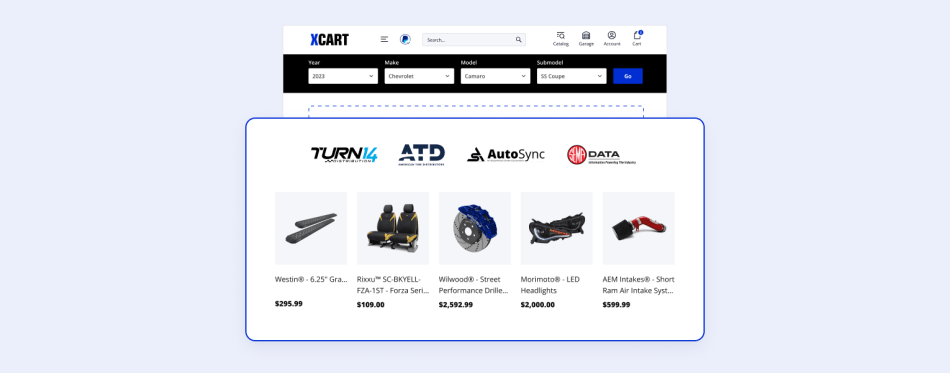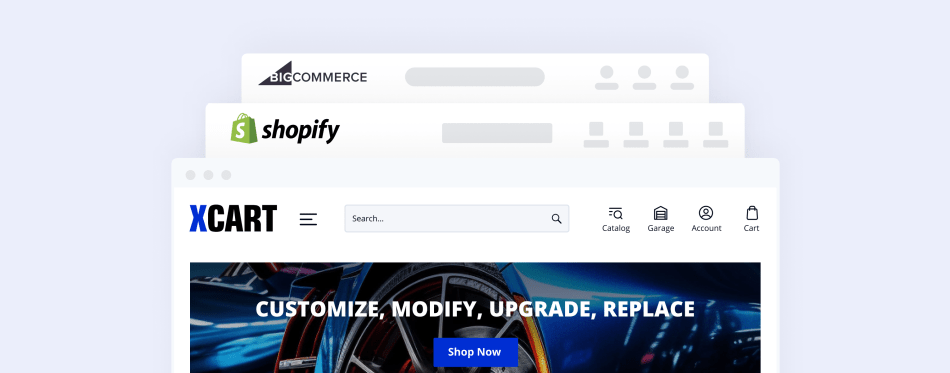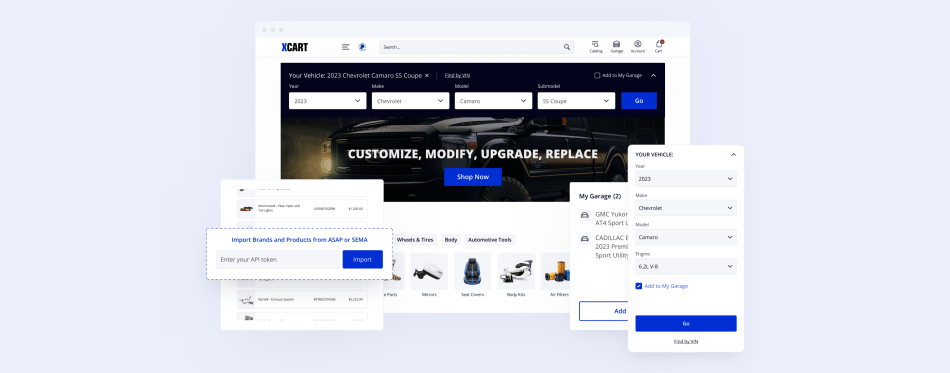Choosing a Custom eCommerce Solution
eCommerce business owners need to be able to customize and configure their online stores to suit their needs and attract target customers. But finding an eCommerce platform that allows for customizations and integrations—and provides needed assistance to achieve success—can be challenging. In this pillar page, we’ll look at the configurability and customization options that businesses typically want, and how X-Cart fills those needs.
Table of Contents:
Create a Unique Online Store With The Custom eCommerce Solution
Our online store themes can be fully-customized to make sure your store looks entirely unique. Connect with our experts to learn the details.
Schedule a callWhy a Custom eCommerce Solution is Key
Your online store is how you present your eCommerce business to the world. Aesthetic details such as images, fonts, and layouts are important—as are apps and integrations that make it easy for your customers to find what they need and follow through with a purchase (rather than abandoning their shopping carts).
Developing a strategy for customizing and configuring your online storefront can be overwhelming. Even if you know what you want, designing a custom eCommerce store may involve a significant upfront time investment. And as time goes on, you need to be assured that you can make changes and adjustments when needed without having to expend additional budget on third-party designers and developers.
Choosing the right custom eCommerce solution can help. Let’s look at a few variables to consider.
Developing a strategy for customizing and configuring your online storefront can be overwhelming. Even if you know what you want, designing a custom eCommerce store may involve a significant upfront time investment. And as time goes on, you need to be assured that you can make changes and adjustments when needed without having to expend additional budget on third-party designers and developers.
Choosing the right custom eCommerce solution can help. Let’s look at a few variables to consider.
1. Overall Strategy
Whether you’re preparing to launch a new eCommerce site or migrate from another service, it’s essential to evaluate your overall strategy and how design and marketing fit into that. Focus on the homepage, reaching your target customers, and making the user interface simple and intuitive. Also spend time researching and developing a search engine optimization (SEO) strategy that will help your target customers find you.
2. Long-Term Goals
Even if you’re currently a small business eager to launch an online shop, think of your eCommerce business as a long-term effort rather than a short-term experiment. Plan ahead for growth, envisioning what that will mean for your business, and ensure you choose a platform vendor that will be there to support you long-term and help you as you scale up. Partnering with a provider you can trust—and one that is prepared to support and enable growth—can make a huge positive difference in the success of your business over time.
3. Add-ons and Integrations
Consider the add-on applications and integrations required for your store and find out whether the platforms you’re considering can provide what you need. If you’re a larger business moving online or migrating from another service, those might include your ERP, CRM, or specific distributor systems depending on your industry. All online businesses will want to ensure their financial integrations of choice are compatible with their platform—services such as PayPal, Google Pay, Apple Pay, Stripe, or Square. Also, think about the fulfillment integrations you’ll need, such as the US Postal Service, UPS, and FedEx.
Aesthetic and functional add-on applications such as CloudSearch should also be considered. What add-ons does the platform offer to help make your eCommerce shop unique, accessible, and easy for your target customers to use?
4. Access to API, HTML, and CSS
Regardless of the size of your business, it’s important to have access to coding tools such as HTML, API, and CSS. If you have developers on your team and want to utilize their skills, consider how much access and control each platform allows you to have. Some platforms operate on proprietary coding languages, making it difficult to access and tweak your site manually—so be on the lookout for what you need.
5. Ongoing Customer and Technical Support
Consider whether the platform provides adequate support as you work toward customizing and configuring your site. Even if you have a robust design team in-house, you will want to ensure you have support if there is a problem.
Reach out to our tech experts. They are here to help 24/7.
Reach outThings to Consider When Selecting a Custom eCommerce Platform
If you’re an existing offline business moving into the eCommerce space, can the platform help you adapt existing processes and workflows to the online system? Moving online can be a major hurdle. Ask potential vendors if they’ve helped other customers make the switch, and find out what kind of support they offer.
Does the vendor have a good track record? Will they be there long-term to support your business? Remember, you’re beginning a long-term partnership. Look for a provider that’s been around for a while, read reviews, and talk to their other customers to get a third-party perspective.
Will you have access to API, HTML, JavaScript and/or CSS if needed? If access to coding and design is important to you and your team, ensure that you’ll be able to make changes manually as needed.
Do they provide the add-on apps and integrations your business needs? Have a list in hand and ask about the specific services you know you’ll need.
After the initial design and launch, how easily will you be able to make small design changes/tweaks? Find out whether you’ll have to do this manually or if their team will be available to assist.
Does the platform provide in-house support for customizations, or would you need to rely on a third party? Bringing in third-party services can be helpful, but could add costs, stress, and communication problems.
Does the platform provide the customization options you need? Do they offer support as you develop a strategy and implement a new design? Think about what you want to achieve with your online store and make sure your vendor of choice can provide the templates, features, and design support you want.
Do they charge transaction fees? Find out how much—and whether or not they increase the fees along with the number of SKUs in your store.
Are there any bundles specific to a particular niche or vertical? For example, if you’re a multi-vendor store, find out if they cater to your needs.
Does the platform use open source coding or a proprietary language? Some providers use proprietary programming languages that require specific expertise to manage.
We found that X-Cart was the most flexible and customizable shopping cart compared to the others.
The code structure of X-Cart is very organized. Theming for X-Cart is also fairly simple.
Why X-Cart
21 years of experience in eСommerce
With 24/7 support and advice included and an excellent long-term track record, X-Cart is a dependable solution for eCommerce owners.
Personalized support as you create a strategy and build your site
Our team is available at every stage, from strategy development to later updates.
Unlimited scalability
You can’t outgrow X-Cart, no matter how much or how rapidly your business grows.
Support for offline businesses moving into eCommerce
We’ve helped many customers move their existing business processes online.
Pre-designed, professionally developed themes and templates, plus customization options such as dropdown and pop-up menus
Make your store look exactly how you want it.
Option to add helpful apps, including CloudSearch, payment integrations, and more
Need a specific add-on or integration? Chances are, we have it—and if not, we can build it.
Access to backend development
For those who want to make their own changes and updates, X-Cart allows access to development with API, CSS, HTML, and JavaScript.
In-house design and development teams provide streamlined support
You won’t need to endure the headaches of consulting with multiple third parties to achieve the results you want.
About the author









